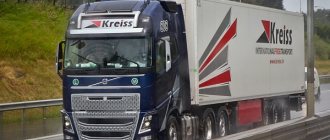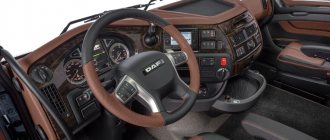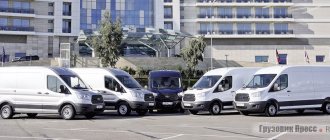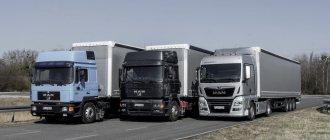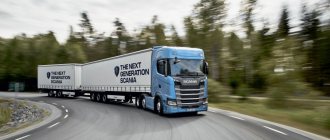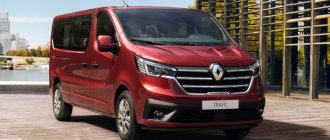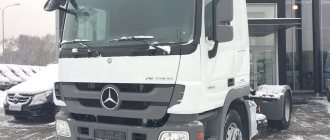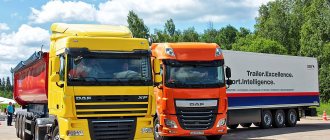The Scania R730 tractor is a long-haul truck, which is designed for transporting goods as part of a road train. High technical characteristics are maintained even when working in difficult conditions.
The first presentation of the car took place in 2005 in Hannover. Over the following years, the model twice took first place in the “Truck of the Year” category, leaving behind competitors from Mercedes and Volvo. In terms of power characteristics, the car was ahead of the previous leader - MAN TGX (680 horsepower).
The truck includes not only a variety of semi-trailers, but also cabs. The latter may contain a sleeping place, which is important when transporting goods over long distances. There is no such place in other variations.
Features of the Scania R730 V8 model
Why do you need such a machine? And to whom? After all, according to statistics and research by Scania itself, the most popular in this segment for many years have been truck tractors with engines up to 480 hp. It is not for nothing that Scania is always the first to introduce engines and cars with a power of “400-something” horsepower to the market.
Scania R730 V8 is an image truck designed to emphasize its status. For Scania - the status of a leading manufacturer of long-haul tractors. For the carrier - the status of a leader in the transport services market.
Therefore, externally, the Scania R730 tractor is all hung with chrome and V8 nameplates, wherever possible. Naturally, it also has the largest cabin possible – Topline – and it looks very impressive. The attractive, modern design of the Scania R730 is closely linked to practicality. A special feature of this tractor is the large black radiator grille (“Black Brilliant”, with a unique grille pattern).
Alarm devices and signs are located separately from the main bumper part. Additional protection is provided by a special grille mounted on the headlights.
The front part of the Scania R730 V8 highway has been lengthened by 135 mm. The high seating position of the driver's seat, huge windows and mirrors create the widest possible view. The aerodynamic performance of the truck tractor is enhanced by a large number of bump stops, deflectors and external fairings. Equipped with tall cabs, air intakes and chrome wheel bolts, this model was recognized as the standard for beautiful design among long-range trucks.
This powerful tractor makes the greatest impression while the engine has not yet warmed up, and clouds of white smoke are emitted from the exhaust pipe under the restrained roar of the G8. As soon as the diesel engine reaches operating temperature, its exhaust becomes transparent and only the inimitable sound of a super-powerful V8 remains. This sound is not loud, but very deep, inspiring respect.
This car was created for use under constant heavy loads and in difficult weather conditions. If we talk about Scandinavia, they have been “experimenting with superheavies” for a long time. Even with three-link super-long road trains with a total weight of up to 90 tons, and their standard “coupling” is 60 tons. But in our country the maximum weight of a road train is limited to 38 tons, and the length is 20 m.
Modifications
When launching this model into mass production, design engineers were not limited by any requirements for design, comfort, or truck chassis configuration. Currently, Scania produces tractors with a varied number of axles: 4x2; 4x4; 6x4; 8x6;10x4.
A wide range of frame options can allow you to transport not only cargo trucks, but also cars on car transporter platforms, tanks with petroleum products or bulk materials, and containers. Modifications of the truck tractor differ in the complete sets of auxiliary equipment and lists of additional equipment.
Scania R730 V8 with 13 axles and was able to demonstrate a record payload of 105 tons.
Scania R730 V8 engine
Scania R730 truck tractors are equipped with eight-cylinder V-shaped diesel engines with a displacement of 16.4 liters. Supplemented with a Holzet turbocharger, this 32-valve power unit develops the highest power in its class - 730 horsepower (ranging from 1,900 rpm). Diesel fuel consumption per 100 km of travel is, at maximum load, 44 liters, according to the manufacturer. The maximum torque of the V8 engine is 3500 Nm (range from 1000 rpm to 1350 rpm). Rotation speed – 1500 rpm. The fuel tank holds 500 liters of fuel.
In general, the Scania V8 engine has been around for many years, even decades. It is a true benchmark for high performance, power and serious torque. These parameters are combined with reinforced concrete reliability, durability and operational efficiency.
Current Scania V8 engines use SCR technology and have been redesigned to meet Euro 6 emissions requirements, without the need for exhaust gas recirculation (EGR). These engines have become not only more reliable and easier to maintain, but they have begun to breathe even more freely, and it is better to use the energy of exhaust gases in the operating speed range of the diesel engine, thanks to the higher temperature of the exhaust gases. Scania V8 powertrains using only SCR technology optimize power and fuel efficiency, since emissions are controlled mainly by the aftertreatment system. The result is excellent fuel efficiency, reducing diesel fuel consumption by up to ten percent.
Each cylinder block has a single cast iron exhaust manifold that covers all 4 cylinders of its block. It is sealed with a system of special cuffs and is connected to a steel pipe with a corrugated sleeve that goes to the turbocharger. This innovative design increases the efficiency and reliability of the turbocharger, while simultaneously reducing diesel consumption and weight. And with its help, by the way, “that same” legendary solid sound of a working V8 is formed.
The fixed geometry turbocharger (FGT) with double scroll technology is lighter and simpler in design and has more convenient piping. It minimizes the pulse interaction of exhaust gases from different cylinders and increases the efficiency of using the useful energy of the exhaust gases. This solution, in combination with new reinforcement, reduces excess weight and increases strength. The new location of the turbocharger also reduces the temperature in the rear of the engine and further on the chassis.
The powerful engine is good for transporting heavy loads across any terrain, including mountainous and hilly terrain, and overtaking with it can be completed more quickly, efficiently and safely.
Advantages
The advantages of the Scania R730 include maneuverability and ease of operation, but the disadvantages are its high cost. At the same time, the equipment quickly pays for itself due to productivity and wear resistance.
Careful elaboration of interior details ensured maximum driver comfort. The ergonomic dashboard features gauges and controls that are easy to see and accessible. In terms of exhaust quality, the power plant of the Scania R730 tractor fully complies with modern standards and has a Euro-6 certificate.
Transmission Scania R730 V8
The transmission in this car is automatic, Opticruise 12+2, with an automatic tilt sensor. It guarantees the driver of the flagship tractor comfortable control of a multi-ton vehicle even in extreme terrain and weather conditions. Climbing steep slopes is quite easy to overcome. For applications where low speed traction is required, this gearbox is equipped with additional crawler gears.
One of the advantages of the Opticruise transmission is the tilt sensor mentioned above. Thanks to this sensor, the car “sees” the topography of the road it is moving on and “doesn’t rush” to engage higher gears on uphill slopes.
The automatic transmission allows you to move in twelve speed modes, plus two gears are also intended for reverse movement. A special feature of this truck is the hydraulic retarder, which is integrated into the Scania R730 gearbox and directly acts on the drive shaft. Functioning in conjunction with the speed controller, the automatic transmission provides smooth movement and good response. The transmission has several specially tuned shift algorithms: normal, economical and power. The gearbox is controlled using the steering column lever, and the data is displayed on the display.
Power and efficiency directly depend on the correct actions of the driver of a heavy tractor and on the selected transmission. With Scania's Opticruise gearbox, gear shifting is more closely controlled, increasing operating efficiency and helping to save on diesel fuel.
Opticruise is an intelligent system that matches the speed perfectly and ensures smooth, smooth gear changes in any situation. The driver can adjust gear shifts at any time, or change gears manually using the lever on the steering column. There is a clutch pedal for starting and stopping, as well as for precise maneuvering. Gear ratio divider – 11.27-1.0.
Features of the design of the suspension, chassis, brakes of the tractor
The truck tractor is based on a reinforced, heavy-duty spar (ladder) frame, on which the cabin is mounted using a four-point air suspension. The front axle of the Scania R730 is equipped with a dependent architectural structure, on parabolic springs and with a transverse stabilizer. The rear axle of the truck tractor is equipped with a two-cylinder air suspension. And on three-or more axle versions of this truck tractor, a balancer suspension is often used at the rear. On the second axle (and on the third one too, in cases where there is one), a gable tire is installed.
The front suspension of the Scania R730 is equipped with parabolic springs. The one-piece rod, which is part of the anti-roll bar, is made specifically for more reliable interaction with the frame of the chassis leveling system.
This car comes standard with EBS and ABS brake systems. In the maximum configuration, towing devices can withstand a load of 35 tons. The anti-rolling system guarantees safety, increases the durability and wear resistance of the entire structure of this tractor unit.
Cabin Scania R730 V8
To get into the cabin, you need to climb four rather large steps. After this, the driver finds himself in a well-known, detailed interior. From the point of view of ergonomics and comfort, there are very few equal to it on the long-haul tractor market.
The interior is decorated with high-quality soft plastic, two full-fledged sleeping berths on “wooden” shock absorbers, with spring mattresses. The seats are upholstered in corrugated leather, and the steering wheel is not only trimmed with leather, but also with wooden inserts. A special pride of Scania engineers is the extremely convenient folding table in the passenger seat. The design is simple, with a minimum of details and elementary kinematics, but the table turned out to be very solid and rigid. Other automakers also looked at this solution, but for some reason they still couldn’t make it so simple and reliable.
In terms of seat comfort, the Scania R730 can only be compared with the newest fourth-generation Mercedes Actros. These are leather ergonomic seats with armrests and a control panel. The steering wheel of the Scania R730 can be adjusted in both tilt and height. The berths in the cabin of Scania's flagship are equipped with lamps on movable brackets, and from the lower berth, using a remote control, you can control everything possible in this cabin.
In the top version of the car, the cabin equipment is very rich and varied: in addition to the usual “long-range” equipment, there is also a coffee maker, microwave, refrigerator with freezer, and an electric sunroof.
The Scania R730 Topline cabin is 2.2 m high and 2.13 m wide. The lower berth, 0.8 m wide, is located in it at a height of 39 cm from the floor. You can conveniently climb onto the top shelf using a folding ladder. On the floor there is a leather rug with corrugation in its central part. The excellent sound insulation of the interior of this truck practically reduces the entire noise level to zero. The Highline cabin differs from the top version in interior height: it is 1.91 m.
Device
Scania P380 dump truck design
Cabin
The Scania R730 tractor is equipped with a high driver's cabin of the TopLine modification. Its design provides the highest comfort and level of operator safety, convenient placement of all main control mechanisms.
To get into the interior of the truck, you need to climb steps that are placed with some offset. The cabin design is quite attractive, which is achieved by using particularly high-quality materials. The seats for the driver and passenger and the control panel are decorated with leather inserts.
Characteristics of the Scania R730 cab and other truck models
The height of the cabin is 2.23 m, so it is comfortable for people to be there. The advantages of the Scania R730 tractor include the ability to install a coffee maker, refrigerator, microwave oven and other household appliances.
There is a table in the glove compartment in front of the passenger seat. In terms of convenience and design, it is no different from the driver's one. The chairs can be adjusted in height and tilt. It is possible to change the position of the steering wheel, which is also very convenient. You can adjust the distance between the driver's seat and the front panel. It varies in the range of 0.23–0.63 m.
The tractor cabin has many niches and shelves where you can store personal items. There is a hook for a garbage bag.
Optional equipment
Reinforced steel bumper with running boards. Headlight protection. Spare wheel bracket behind the cab.
Tire inflation device with hose.
Hydraulic jack. Front wheel caps.
Wheel nut protection. Wheel stops - 2 pcs.
Weight and dimensions characteristics of Scania R730 in numbers
- Vehicle (tractor) weight – 7800 kg.
- The total weight of the road train is 40,000 kg (in accordance with the standards adopted in the European Union).
- The maximum load on the front axle is 9000 kg.
- The maximum load on the rear trolley is 30,000 kg.
- Center distance – 3300 mm.
- Front suspension: parabolic springs 4X28.
- Rear suspension: multi-leaf springs 10X25/90.
- Size of stamped steel wheels – 9.00/22.5″ – 8 pieces, 11.75/22.5″ – 3 pieces, including a spare wheel.
- Type and size of front tires – Michelin 385/65 XZY3 – 3 pcs.; rear tires – Michelin 315/80XDY3 – 8 pcs.
- Overall dimensions of the tractor: length – 6,213 m, height – 3,100 m, width – 3 meters (including external rear-view mirrors).
Specifications
Scania R730 V8 has in its arsenal a full range of innovative functional capabilities that are typical for equipping modern tractors. The Scania Opticruise technical system line consists of improved operating mode control in high-load (off-road) conditions, traction control mechanisms and a retarder device, which increases the vehicle's ability to travel at low speeds, that is, reduces the technical wear of truck parts.
Scania R730 tractor unit
The technical characteristics of the R730 as a cargo SUV have also improved thanks to changes made to the bumper part of the car. The front part of the vehicle has become longer than that of previous truck models, which serves as protection against minor impacts when the vehicle collides with unexpected obstacles. Increasing the bumper by eight centimeters lengthens the front part of the truck by 13.5 centimeters, and the safety margin of the protective device allows the frame to be preserved without visible deformation even with a strong, single impact. To preserve the mechanical components of the truck, the bumper is secured slightly apart from the main machine structure.
The Scania R730 Topline is equipped with a robust towing attachment that can easily withstand a thirty-five tonne load force, which exceeds the towing capacity of other vehicle models by ten tons. This factor is a predominant quality in the event of a failure of the mechanical chassis of a truck. If the truck breaks down, it can be towed without having to unload the trailer body. A protective bumper screen installed directly on the bumper guard prevents damage to the lower part of the cooling system for natural air flows received by the radiator when the vehicle is moving. This innovation also serves as a protective device for the front section of the tray.
Engine
The car is equipped with a V-shaped eight-cylinder engine with a capacity of 730 horsepower. The volume of such an engine is 16.4 liters. Compared to previous versions of the car, the amount of harmful particles in the exhaust has decreased by 90%, nitrogen oxides, carbon and unburned hydrocarbons - by 30-40%.
Its main advantages include maintainability and ease of maintenance work. Replacement is carried out in record time thanks to standardized components used in other models of the manufacturer. Oil is pumped into the hydraulic drive manually. This unit is responsible for raising the cab for access to the engine compartment.
| Power | 730 hp |
| Fuel | diesel fuel |
| Number of cylinders | 8 |
| Torque | 3500 Nm |
| Engine volume | 16.4 l |
| Fuel tank volume | 500 l |
The maximum torque of the Scania R730 engine is 3500 Nm, and the shaft speed is 1500 rpm.
Thanks to these characteristics of the installation, you can easily climb a large slope. Excellent sound insulation can significantly reduce the noise level in the cabin, which has a positive effect on the driver’s well-being.
Fuel consumption
The fuel tank holds 500 liters. The fuel consumption of the Scania R730 at maximum body load is 44 liters per 100 km.
checkpoint
The Scania 730 is equipped with an automatic gearbox and a high-quality cooling system. The gearbox works in conjunction with the speed controller, which guarantees smooth movement and good response. The gearbox allows movement in 12 different speed modes (2 reverse speeds), it is fully synchronized. The clutch pedal is necessary for starting, and also in some cases when braking. Gear ratio divider – 11.27-1.0.
Chassis
Rear chassis
The front suspension is equipped with parabolic springs. The anti-roll bar features a one-piece bar that ensures reliable interaction with the frame. The standard equipment includes the installation of a chassis level adjustment system.
Front wheel
Brake system
The standard assembly includes the installation of EBS and ABS brake systems, as well as disc brakes, which can be removed without the wheel rim. For the safety of the Scania 730, an anti-rolling system is installed; it operates from a switch located on the instrument panel. When activated, movement will begin only after pressing the gas pedal. The advantages of the system are increased durability and wear resistance. When driving downhill, the system can be turned on automatically or forcefully.
Chassis
Max. front axle load, 9000 kg
Max. rear bogie load, 30,000 kg
Center distance, 3300 mm
Load capacity, 24000 kg
Front suspension: parabolic springs 4X28
Rear suspension: multi-leaf springs 10X25/90
Stabilizer on the front axle, normal rigidity. Stamped steel wheels. Size 9.00/22.5″ - 8 pieces, 11.75/22.5″ - 3 pieces, including spare wheel
Tires: front – Michelin 385/65 XZY3 – 3 pcs. rear – Michelin 315/80
XDY3 – 8 pcs.
Middle Bridge
Rear axle
Electrical equipment
Scania P380 has a pair of batteries with a capacity of 180 Ah, 24 V, with a switch. A generator with a capacity of 100 A is installed.
The dump truck is equipped with:
- adjustable high and low beam headlights;
- anti-fog headlight;
- rear lights.
There is lighting equipment (headlights with enhanced protection) on the visor and dimensions.
The steel bumper is reinforced and equipped with running boards. There is a spare wheel located behind the cab. There is a compressor, a hydraulic jack, hubcaps and wheel stops.
The dump body with rear unloading has a length of 6.3 m, volume V = 16 m3. The Scania body is made of high-strength steel. It is heated by the exhaust. An awning is attached to the walls of the body.
Reviews of Scania R730
According to reviews from drivers who have tried the Scania R730 in action, with such a power reserve it is not difficult to fit into the traffic flow - whether in the city or on the highway. Moreover, the most important driving sensation is not the dynamics, although they are, of course, impressive. If you press the pedal “to the floor”, then the automatic transmission, having quickly gone through all the gears, will very soon make you “hang” on the limiter. The main thing is an intuitive understanding with a heavy machine. You get the strong impression that the car directly anticipates your desires, braking the engine in time to release the gas and also accelerating - on demand. There is cruise control.
The driver's seating position is very close to that of a regular car, and a comfortable position can be found very quickly. The low-set mirrors do not interfere with the view at all, the dashboard neatly “envelops” the driver on the sides, and everything that is necessary is immediately visible on it, just a quick glance is enough.
The complete silence inside the car is impressive: you can talk, listen to music, and so on, absolutely calmly, without even raising your voice.
Surprisingly, the diesel fuel consumption of this heavy-duty truck is not much greater than that of the 480-horsepower version. However, maintenance, of course, probably costs noticeably more, plus taxes, and, naturally, the rather considerable cost of the car itself.
However, all this cannot stop the fans. Because the top long-haul tractor from Sсania is more than just a truck. This is an opportunity to prove to the whole world that your company is the coolest. And continue to show it to everyone every day. The Scania R730 V8 is a car for those who demand more. Therefore, owning this truck becomes an open statement that speaks for itself - a statement of your ambition and aspirations. And they are reflected, as in a mirror, in the exclusive style of this car.
The undoubted advantages of this model of truck are simplicity and maneuverability of operation, and its serious price soon pays off - due to the high level of performance, durability and reliability in conditions of merciless operation.
New generation of highways: test drive Scania S730
The new generation of Scania has been awaited for more than 20 years. The previous, fourth, series appeared in 1995 and experienced two restylings (in 2005 and 2013). Logically, the new Scania should be called the “fifth” generation, but the Swedes themselves avoid this name in every possible way and limit themselves to the term “new generation”.
Before the trip to Sweden, I was sure that only the cabin had been updated - especially since just three years ago a restyled version of the Scania Streamline with the most advanced solutions was shown... However, there were many more changes - this is truly a new car. The 20 billion Swedish crowns (about 2 billion euros) spent on the development of the new generation were not wasted in vain!
Subject of fierce controversy
The new design of Scania does not leave anyone indifferent - there is a wide range of opinions: expected from the assessment of “cool” to “completely sucks” and “ruined the bench”... In fact, such a reaction is predictable - exactly the same opinions were expressed after the premiere of the new generation Mercedes Actros MP4 in 2011, and Volvo FH in 2013... Perhaps the ratings there were even sharper. But several years have passed, and new Mercedes and Volvo have already become familiar. The same will most likely happen with Scania. The fact is that mainline carriers are one of the most conservative groups of buyers; only bus owners are more conservative than them - they generally do not like innovations.
So design is a matter of taste, and although it is interesting, it is not the first thing. The functionality is much more interesting - and there is something to talk about here. Let's start with the fact that the new Scania now sports four-story lighting technology: while the combination of working and fog lights in the bumper and under it has long become familiar, the new generation of trucks now has LED running lights, which is also expected. But further... The narrow triangles under the windshield are not dimensions - these are high beam headlights! The same can be said about the lights in the upper corners of the cabin. In general, even in polar night conditions, the installation of additional “chandeliers” will not be necessary.
1 / 6
2 / 6
3 / 6
4 / 6
5 / 6
6 / 6
The windshield turned out to be just as flat as on its predecessor - and this is good, and in combination with the fact that the driver's seat was moved forward, visibility even improved. Large mirrors eliminate blind spots, and additional mirrors above the passenger door and windshield are now powered, so you can park close to curbs without risking crushing anything.
The appearance is completed by evidence of serious work on aerodynamics: the sidewalls are covered with metal shields.
The chassis was completely reconfigured: the synthetic urea tank was moved under the frame, the brake receivers were hidden between the side members, and the batteries were placed in the rear overhang. Outside the frame, only the exhaust system and two fuel tanks with a maximum volume of 1,500 liters remained. In addition, the wheelbase was increased by 50 mm to improve weight distribution.
Location
To get into the “top” cabin, you need to climb four steps, two of which are blocked by a door. The largest cabin is now called: “S-series”. There is a flat floor and an internal height of 207 cm. The space is unreal, even reaching a passenger is a problem. The Scania “fourth series” had the best seating position and adjustment ranges for the steering wheel and seats - this gave rise to fears that in the new generation the parameters might change to suit the design... But they were in vain - the ranges are huge! You can sit like in a car, with the driver's seat completely lowered to the floor and the steering wheel raised as much as possible - or vice versa. At the same time, the maximum height of the driver that the Skaniya team was counting on was 212 cm!
This is not just another “tail” on the old frame - this is truly a new cabin. At the moment, there are two versions: as the Scanians themselves call them, “20-inch” and “17-inch”. Both are equipped with sleeping places, but the first, as you guessed correctly, is larger, and it can accommodate a sliding sleeping shelf almost 1 meter wide. In addition, there are three roof height options. Later, “day cabs” without a bed will be shown for construction equipment and delivery trucks.
The plastic trim in all cars is soft, and the sound and vibration insulation is impeccable - unlike some competitors, everything here is really very good.
Of course, the list of options is long, and there are a lot of design options - from the simplest with a plastic steering wheel and “rag” seats to the most expensive, completely trimmed in leather and equipped with coffee makers, microwaves, TVs, refrigerators and hundreds of other options.
I got the top-end configuration for testing, and it’s easier to say what wasn’t there – there was no coffee maker. Everything else, including the refrigerator and tablet, was there.
The berth is another reason to look into the cabin. It has cutouts for the backs of the driver and passenger seats: the width of the shelf behind the backs is about 55 cm, and in the middle - 75 cm. The length of the sleeping shelf is 215 cm! In the S-series cabin, the seats move forward in one motion, and the berth can be further moved apart by 20 cm. However, you have to put in a lot of effort - the handle you have to pull is too small.
Working space
When you move from your sleeping place behind the wheel, you realize that the “center of the universe” is still right here. In the top-end configuration, the steering wheel itself is trimmed with high-quality leather, very pleasant to the touch. The cross-section and shape can be considered optimal, and the lower segment of the steering wheel is cut off - not in a sporty way, but rather, taking into account beer lovers with voluminous bellies.
On the steering wheel, of course, there are control buttons for the media center, on-board computer, hands-free system and active cruise control. The instruments, which retain the same location as in the Streamline version, are still clearly legible in any lighting - this, however, is a formal remark.
But the right steering column switch is somewhat overloaded: it contains control functions for the automated Opticruise gearbox with the ability to switch in manual mode, plus control of the retarder and two-stage engine brake - you will have to get used to this.
But the handbrake turned out to be familiar and sticks out on the front panel. The developers assured us that a “button” will soon appear - the same as that of competitors. But for now, according to the chief designer, “customers are conservative people, and they wanted to see a normal handbrake handle on the front panel.”
The front panel itself, according to the Scanie tradition, is turned towards the driver, and in order to use secondary functions, you do not have to lift your back from the seat. And there are many of these functions. In addition to navigation with three-dimensional European maps and a good radio, the multimedia complex is equipped with a two-channel Bluetooth system - now the driver can connect not only a business phone, but also a personal phone to the hands-free system. And in order to charge it, there are as many as three sockets with USB connectors on the front panel, plus one more on the rear wall of the cabin. In general, there will be no discharged gadgets in the cabin. Under the media center there is a climate control panel and transmission control buttons. In general, there are quite a few buttons - but still fewer than those of competitors.
And here we come to the most interesting part. The control panel for mirrors, windows and lights is located on... the left window sill! Yes, yes, exactly on the driver's door. Using all this is quite convenient, but... What happens if the buttons and joysticks are flooded with water?
How will the wire loop behave in the driver's door? We asked these questions to designers and engineers - their answer can be translated approximately as follows: “all these functions have been subjected to multiple tests, both mechanical (opening and closing doors, pouring water) and thermal (cooling and heating), and everything should work as normal okay”... In my opinion, the decision is more than ambiguous.
Driving force
Under the new cabin are new engines: a 13-liter inline six, the maximum power of which was increased to 500 hp. s., and torque up to 2,200 Nm, and a 16-liter V8 (the only one in the world that meets Euro 6 standards), covering a power range of 520–730 hp. With. The new engines have abandoned the exhaust gas recirculation (EGR) system and achieve Euro 6 standards only by injecting synthetic urea AdBlue into the exhaust tract (SCR technology).
Test drives / Truck Elon Musk's nightmare: test drive a Scania G340 on methane The future worries everyone. Some simply don’t sleep at night until they can look into the hazy, shining prospects of environmentally friendly, efficient and inexpensive transport. Technically illiterate... 12504 0 7 06/01/2016
To achieve this, a lot of work had to be done. The compression ratio was raised to 20.1:1 - this is a lot for a heavy-duty turbodiesel truck! In addition, engineers optimized the combustion chambers, abandoned the variable geometry turbine, completely modernized the intercooler system and increased the radiator area. The engine operates in a fairly harsh mode, but the developers promise that this will save up to 3% of fuel.
the OptiCruise automated transmission was not changed - it is already the best in the class. It’s not for nothing that MAN is abandoning its own transmissions from 2022, and OptiCruise will be installed on their trucks.
The drive axles also remain the same, the only innovation is the ability to order the main pair with a gear ratio of 2.35:1. But such vehicles are irrelevant for Russia - they are an economical main pair for good European roads, where long-haul trucks on 18-inch wheels can be used, and the routes run along the plain. One last passing note about the technology: the service brakes are, of course, discs on all axles.
Movement into life
The fact that at the first world presentation customers were not allowed to drive is a big omission of the marketing department: the new Scania reveals itself precisely in motion. Only in motion can one appreciate the excellent noise and vibration insulation, the correct operation of the automated transmission, and the maneuverability of the new long-haul tractor.
Scania S730 engines
13 l, 500 hp / 16 l, 520-730 hp
It so happened that the first truck I drove along the highway turned out to be a super-heavy (64 tons) and super-long (24 m) “Scandinavian” road train - such vehicles can go on the roads of Sweden, Norway, Denmark and Finland, and in the rest of the world they are operation is prohibited. But we are in Sweden, and since there was a chance, it would be a sin to miss it.
The first thing I would like to note is a very unusual sensation: you have to drive “by the mirrors.” But do you know what amazes the most? The fact that the entire coupling behaves monolithically, and there are no usual twitches reminding the driver that a rather large tail is trailing behind the car. And the second thing is that the Swedes were able to calculate the kinematics of the trailer in such a way that all its five axles exactly follow the track of the lead vehicle! It is fantastic. And yes, the 730 hp V8 engine (3,500 Nm) from Scania does not feel this heaviness! Later, I specifically checked my impressions on a regular 16-meter Euro truck: yes, the dynamics drop a little, and on a descent the retarder can be used not fully, but a couple of steps less - but in general the car behaves predictably, and 64 tons of total mass is simply not are felt.
I really liked the modernized retarder. This is a whole system that uses the service brakes, the transmission (actually, the retarder itself), and the engine brake at different stages. The service braking system is engaged early on to prevent trailer jacking on slippery slopes - and then braking is handled entirely by the transmission. On an 8% descent, the 64-ton road train confidently maintains the set speed, and the service brakes only have to be used to stop completely.
Well, as is customary on Scania, as soon as the retarder is turned on, the fuel supply is completely cut off. This is a real saving on both fuel and brake pads.
The simple, human driving experience is the most positive - sound insulation and suspension performance are excellent. The car simply floats both over the asphalt road and over the cobblestones of the “Brussels pavement”. In any driving mode, you can talk in the cabin without raising your voice - few passenger cars can provide such a level of comfort.
Summary
The car turned out to be successful, comfort, economic and environmental indicators are excellent - in general, everything is great. However, no one can yet say how much such beauty costs, because in Russia these cars will appear with Euro-5 engines and not earlier than in a year. At best, in the fall of 2017, and, most likely, from the beginning of 2022.
In Sweden, the price for the top-end Scania S730 is 150 thousand euros. Expensive? But Scania has never been cheap - after all, it is a real premium. And it's worth the money. And I’m not the only one who thinks so: those carriers with whom I managed to communicate are ready to order this car now.

